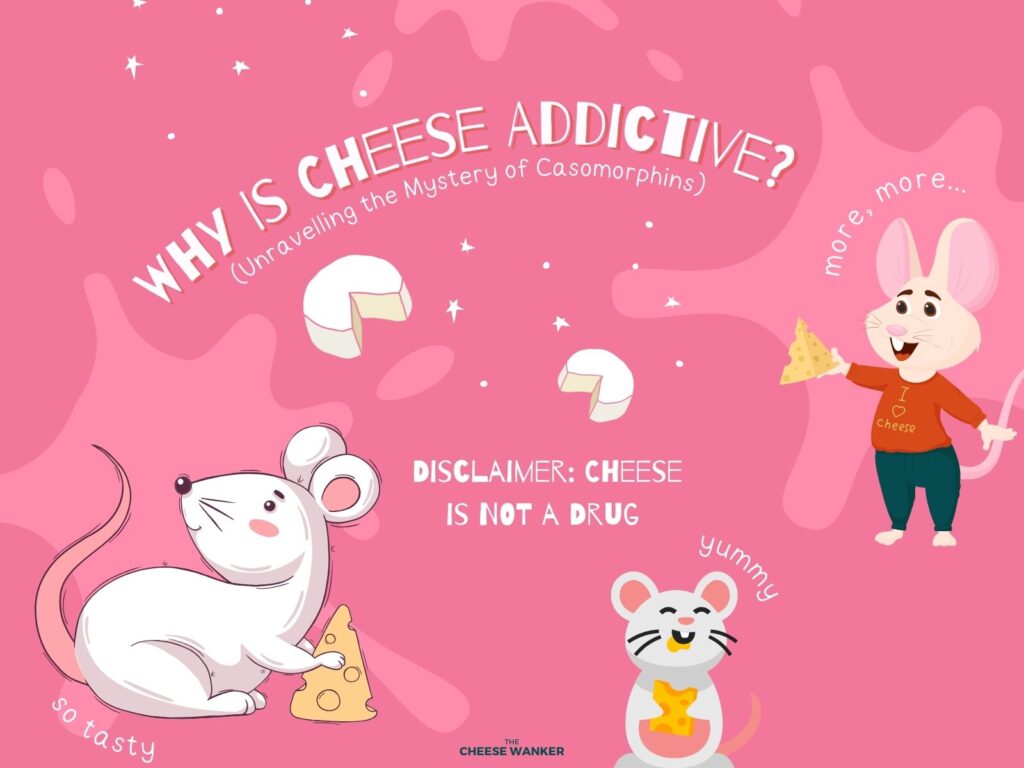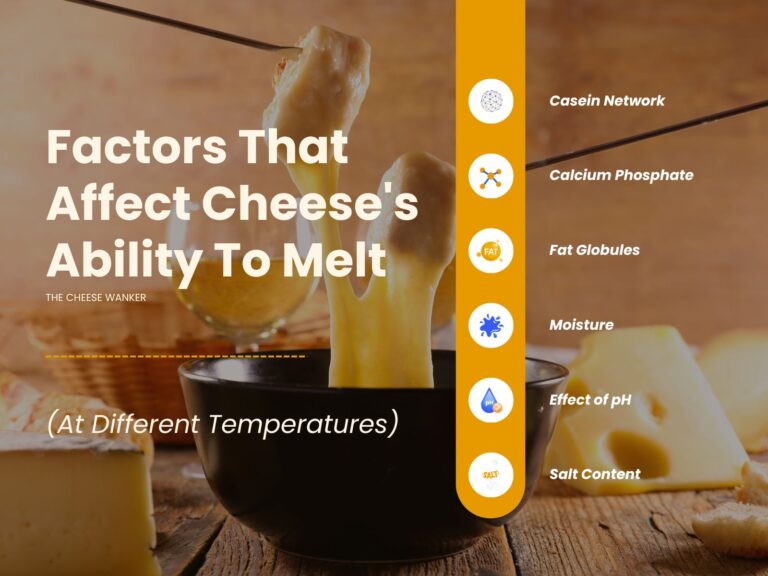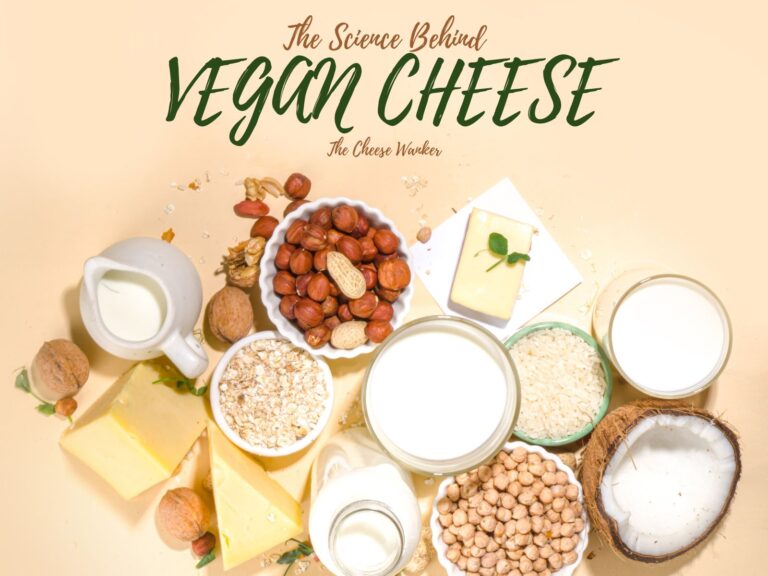Cheese, with its creamy textures and savoury flavours, has an undeniable allure that can be hard to resist. Have you ever wondered why it can be addictive? In this article, we’ll explore the scientific and sensory reasons behind our cheese cravings, including the intriguing role of casomorphins. So, let’s dive right in.

Disclaimer: Cheese is NOT a Drug
Before we embark on our exploration into the addictive allure of cheese, it’s essential to clarify a crucial point: Cheese is NOT a drug.
While we will delve into the fascinating science behind casomorphins and their effects on the body, it’s important to emphasise that the term “addictive” in relation to cheese does not equate to a chemical addiction.
Cheese, like many other foods, can elicit pleasurable responses and cravings due to its sensory attributes, cultural significance, and the interaction of compounds like casomorphins with our brain’s reward system.
However, these cravings and pleasures are distinct from the intense, potentially harmful cravings and dependency associated with drugs and alcohol.
Understanding the factors that make cheese appealing and potentially habit-forming in some individuals allows us to approach its consumption with mindfulness and moderation. It reminds us to appreciate the complexities of our relationship with food and to make informed choices that promote our overall well-being.
So, while cheese may have an addictive allure, it’s a far cry from being an addictive substance.
Why do some people find cheese addictive?
With our disclaimer out of the way, let’s take a deep dive into why cheese can be considered addictive.
1. Fat content
Cheese is relatively high in fat, which can make it quite satisfying and pleasurable to eat. Fats are known to stimulate the release of feel-good neurotransmitters like dopamine in the brain, which can contribute to the sensation of craving more.
2. Umami flavour
Moreover, cheese is rich in umami, one of the five basic tastes (alongside sweet, salty, bitter, and sour). Umami is often described as savoury or meaty, and it can be highly rewarding to the taste buds, making you want more.
3. Texture
The texture of cheese can vary widely, from soft and creamy to firm and crumbly. Therefore, the combination of textures in cheese can be pleasurable and contribute to the desire to consume more.
4. Salt content
Many cheeses are relatively high in salt, and salt is another taste that can be rewarding and make you crave more. It’s also worth noting that the combination of salt and fat is known to be particularly appealing to our taste buds.
Want to know why cheese is so salty? We’ve got all the answers in this article on the role of salt in cheesemaking.
5. Cultural and social factors
Furthermore, cheese is often associated with social gatherings, celebrations and comfort food. These cultural and social factors can contribute to the pleasurable experience of consuming cheese and reinforce the desire to eat it.
6. Personal preferences
Of course, people have individual preferences and cravings for certain foods. And for some individuals, cheese may be especially appealing and difficult to resist due to their personal taste preferences.
7. Opioid-like compounds:
Some studies have suggested that dairy products like cheese contain compounds called casomorphins. While the evidence is not conclusive, it’s theorised that these compounds may play a role in the pleasurable sensations associated with cheese consumption.
Next, we take a closer look at casomorphins and their effect on the human body.
What are casomorphins?
Casomorphins are peptides that can have opioid-like properties. As a result, they can influence our bodies in fascinating ways.
While research on casomorphins is ongoing, there’s evidence to suggest their presence in cheese. Studies have detected these opioid-like compounds in dairy products, contributing to their potential addictive qualities.
Where do casomorphins come from?
The process of casomorphin formation begins during the digestion of casein. Casein is the primary protein found in milk, including cow’s milk, which is the most commonly used milk source for cheese production.
Enzymes in our digestive system, such as pepsin, cleave casein into smaller peptide fragments. Some of these fragments, particularly those derived from beta-casein, are the casomorphins.
These casomorphins have structures that resemble opioid molecules, hence their name, which is a fusion of “casein” and “morphine.”
What do casomorphins do to the body?
When casomorphins interact with the body, they can have several notable effects, including the release of dopamine, which is often associated with feelings of pleasure and reward.
Here’s a closer look at the effects of casomorphins:
1. Mood enhancement
Casomorphins can bind to specific receptors in the brain, known as opioid receptors. When this binding occurs, it triggers the release of neurotransmitters like dopamine.
Dopamine is a key player in the brain’s reward system and is associated with feelings of pleasure and well-being. Consequently, the consumption of casomorphin-producing foods, like cheese, can lead to an elevation in mood and a sense of satisfaction.
2. Appetite modulation
The interaction of casomorphins with opioid receptors may also influence appetite regulation. Indeed, some studies suggest that casomorphins can affect the brain’s perception of hunger and fullness.
As a result, this can lead to increased food intake, particularly of cheese and other dairy products.
3. Digestive impact
Furthermore, casomorphins might exert effects on gastrointestinal motility and digestive processes. Some individuals may experience changes in bowel movements or gastrointestinal discomfort after consuming casomorphin-rich foods, although these effects can vary widely from person to person.
It’s essential to note that while casomorphins can influence mood and appetite, their effects are not as potent or addictive as those of drugs like opioids.
The release of dopamine and subsequent feelings of pleasure from casomorphins in cheese are relatively mild compared to the intense euphoria associated with opioid drugs.
Additionally, the response to casomorphins varies among individuals. Some people may be more sensitive to these compounds, while others may experience minimal effects. Factors such as genetics, tolerance and overall diet can all play a role in how casomorphins affect an individual.
Conclusion
In our exploration of why cheese can be addictive, we’ve unveiled some of the tantalising mysteries behind our love affair with this dairy delight. Cheese’s irresistibility is not merely a matter of taste and texture. But rather a complex interplay of sensory pleasure, cultural significance, and the fascinating chemistry of casomorphins.
From the rich umami flavour and creamy textures to the social bonds it forges, cheese has a way of capturing our hearts and palates. Casomorphins, derived from the breakdown of casein, add an extra layer of allure by interacting with our brain’s reward system, releasing the pleasure-inducing dopamine, and potentially influencing our appetite.
However, it’s crucial to remember that while cheese can be a source of culinary joy, it’s not an addictive substance in the way drugs are. Understanding the factors that make cheese so irresistible empowers us to enjoy it mindfully, as part of a well-balanced diet.
So, the next time you savour a slice of your favourite cheese or indulge in a cheesy dish, do so with appreciation for the intricate world of flavours, textures and chemistry that make cheese a culinary masterpiece.
Embrace the pleasures of cheese in moderation and let your love for this beloved dairy treasure be a mindful and enriching part of your culinary journey.



